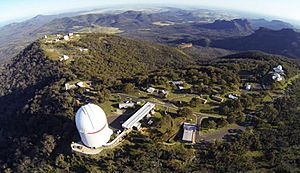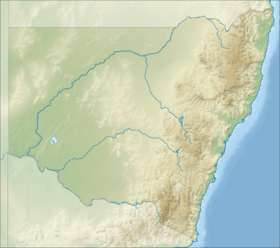Siding Spring Observatory facts for kids
Quick facts for kids Siding Spring Observatory |
|||||||||||||||||||||||||
|---|---|---|---|---|---|---|---|---|---|---|---|---|---|---|---|---|---|---|---|---|---|---|---|---|---|

Siding Spring Mountain with Anglo-Australian Telescope dome visible near centre of image.
|
|||||||||||||||||||||||||
| Organization | Research School of Astronomy & Astrophysics at the Australian National University | ||||||||||||||||||||||||
| Code | 413 | ||||||||||||||||||||||||
| Location | Siding Spring Mountain/Mount Woorat, near Coonabarabran, New South Wales, Australia | ||||||||||||||||||||||||
|
Coordinates
|
31°16′24″S 149°03′52″E / 31.27333°S 149.06444°E
|
||||||||||||||||||||||||
| Altitude | 1,165 m (3,822 ft) | ||||||||||||||||||||||||
|
|||||||||||||||||||||||||
| Mount Woorut | |
|---|---|
| Siding Spring Mountain | |
| Highest point | |
| Elevation | 1,165 m (3,822 ft) |
| Parent peak | Mount Exmouth |
| Geography | |
| Location | Coonabarabran, New South Wales, Australia |
| Parent range | Warrumbungles |
| Geology | |
| Mountain type | Volcanic |
Siding Spring Observatory is a famous place for studying space. It is located near Coonabarabran, New South Wales, Australia. This observatory is part of the Research School of Astronomy & Astrophysics (RSAA) at the Australian National University (ANU).
It has the important Anglo-Australian Telescope and many other telescopes. These telescopes belong to the Australian National University, the University of New South Wales, and other groups. The observatory sits 1,165 metres (3,822 ft) above sea level on Mount Woorat, also known as Siding Spring Mountain. This mountain is inside the Warrumbungle National Park.
Siding Spring Observatory is owned by the Australian National University (ANU). It is part of a larger research school that includes Mount Stromlo Observatory. There is more than AUD$100 million worth of research equipment here. Over 60 telescopes are on site, though not all are currently in use.
Contents
- History of Siding Spring Observatory
- Why a New Observatory Was Needed
- Building Siding Spring
- The Anglo-Australian Telescope (AAT)
- International Telescopes at Siding Spring
- Las Cumbres Observatory Global Telescope Network
- Robotic Optical Transient Search Experiment (ROTSE)
- HAT-South Telescope Network
- Automated Patrol Telescope (APT)
- PROMPT Telescopes
- Uppsala Schmidt Telescope
- Korean Microlensing Telescope Network (KMTNet)
- SkyMapper Telescope
- Solaris 3 Telescope
- Japan Aerospace Exploration Agency (JAXA) Telescopes
- Huntsman Telephoto Array
- bRing-AU Cameras
- 2013 Bushfire
- Visiting Siding Spring Observatory
- Telescopes at Siding Spring
- Space Programs and Discoveries
- See also
History of Siding Spring Observatory
The first big observatory in Australia was Mount Stromlo Observatory, built in 1924. After World War II, scientists there started focusing more on stars instead of the Sun. From 1953 to 1974, the 74-inch (1.9 m) telescope at Mount Stromlo was Australia's largest optical telescope.
Why a New Observatory Was Needed
By the 1950s, the bright lights from the city of Canberra made the sky too bright at Mount Stromlo. This "light pollution" made it hard to see faint objects in space. So, scientists started looking for a new, darker place.
Bart Bok began the search for a new site. Two main spots were considered: Siding Spring and Mount Bingar. Harley Wood, a government astronomer, first suggested Siding Spring for astronomy.
Building Siding Spring
The ANU chose Siding Spring in 1962 because its skies were dark and clear. By the mid-1960s, the ANU had built three telescopes and all the necessary facilities. This included roads, places for staff to live, electricity, and water.
In 1984, the Prime Minister, Bob Hawke, opened the ANU's biggest telescope. It was a 2.3-metre (7 ft 7 in) telescope, known for being affordable and new in its design.
The Anglo-Australian Telescope (AAT)
Since the 1950s, Australia and Britain had been planning to build a very large telescope together. When they finally agreed in 1969, Siding Spring Observatory was already set up. It was the perfect place for the 3.9-metre (13 ft) Anglo-Australian Telescope (AAT).
While the AAT was being built in the early 1970s, the British Science and Engineering Research Council also built the UK Schmidt Telescope. It is about 1 kilometre (0.62 mi) from the AAT. The Schmidt telescope can see a much wider area of the sky. This helps scientists survey large parts of the sky quickly. Then, they use the bigger AAT to study interesting objects in more detail. In 1987, the Schmidt Telescope joined forces with the AAT.
International Telescopes at Siding Spring
Siding Spring Observatory is home to many telescopes from around the world. These include telescopes from Korea, America, the UK, Poland, Hungary, Germany, and Russia. In 1990, a facility that tracked satellites for the Royal Greenwich Observatory closed after 10 years.
In 2012, the first public observatory that could be controlled over the internet opened here. It was set up by iTelescope.Net. It has over 25 telescopes in a large building with a roof that rolls off.
Las Cumbres Observatory Global Telescope Network
Las Cumbres Observatory runs a 2-meter telescope used for research, citizen science, and education. They also have two 0.40-meter telescopes and two 1-meter telescopes. Over a thousand people, from schools to professional astronomers, use these telescopes. This global network helps scientists study the sky all the time and work with other groups.
Robotic Optical Transient Search Experiment (ROTSE)
The Robotic Optical Transient Search Experiment (ROTSE) is run by the University of New South Wales (UNSW). This 0.45-meter robotic telescope has found sudden flashes of light from gamma-ray bursts. Its wide view and fast reaction time help it see things other telescopes might miss.
HAT-South Telescope Network
HAT-South looks for planets outside our solar system (exoplanets). It uses a network of telescopes to watch many bright stars. It looks for a small dip in light that happens when a planet passes in front of its star. HAT-South has three sites in the Southern Hemisphere, each with eight 0.2-meter telescopes.
Automated Patrol Telescope (APT)
The Automated Patrol Telescope (APT) is also run by UNSW. It is a 0.5-meter telescope that takes wide-field images. It can be controlled from far away or work completely by itself. The APT was made by changing an old satellite tracking instrument.
PROMPT Telescopes
PROMPT (also known as Skynet) is run by the University of North Carolina. It has four 0.41-meter telescopes that work automatically. They can quickly observe gamma-ray burst afterglows and other fast-changing objects in space.
Uppsala Schmidt Telescope
The Uppsala Schmidt Telescope was first built in Sweden in 1957. It moved to Mount Stromlo and then to Siding Spring Observatory in 1982. This telescope was used to find Near-Earth Objects (NEOs), like comets. It was also part of the Catalina Sky Survey, which looks for objects that might come close to Earth.
Korean Microlensing Telescope Network (KMTNet)
The KMTNet is a 1.6-meter telescope run by KASI. Its main goal is to find exoplanets using a method called gravitational microlensing. This method can even find Earth-sized planets in areas where life could exist. KMTNet also studies supernovae, asteroids, and other galaxies.
SkyMapper Telescope
The SkyMapper telescope, run by the ANU, is currently mapping the entire southern sky. It completes a new map every three months. This survey will record over a billion stars and galaxies. The telescope also uses special filters to learn about stars' age, mass, and temperature. This 1.35-meter telescope has helped search for Planet 9 and other objects far out in our solar system. It has also found supernovae and the oldest known star in the universe.
Solaris 3 Telescope
Solaris 3 is a 0.5-meter telescope run by the Nicolaus Copernicus Astronomical Center. It is part of a network across the Southern Hemisphere. It uses a new method called eclipse timing to search for exoplanets.
Japan Aerospace Exploration Agency (JAXA) Telescopes
JAXA operates four 0.25-meter telescopes. They use these to find and track space junk and objects near Earth in the Southern Hemisphere.
Huntsman Telephoto Array
The Huntsman Telephoto Array is used by the AAO and Macquarie University. It takes pictures of faint galaxy structures using special camera lenses. It uses a 0.28-meter telescope and seven 400mm camera lenses.
bRing-AU Cameras
bRing-AU is a project by several universities and astronomers. It looks for material around planets, studying dust disks from early times and how icy moons form. They use two small, changed cameras with special chips.
2013 Bushfire
On January 13, 2013, a huge bushfire threatened the observatory. Eighteen staff members had to leave for Coonabarabran. Three buildings were destroyed: a place for visiting researchers, the Director's house, and the Fire Station. However, fire prevention efforts saved the telescopes. Even though smoke and ash got into some domes, all the telescopes survived the fire. The iTelescope Remote Observatory was back online on January 20. The Anglo-Australian Telescope started working normally again in mid-February 2013.
Visiting Siding Spring Observatory
There is a special area for visitors with an exhibition. It also has a café and a gift shop. During school holidays in New South Wales, you can take guided tours of the observatory. If you have a group of more than 15 adults, you can ask for special walking or bus tours behind the scenes.
An Open Day happens every year in October. On this day, you can hear talks about astronomy and go inside many of the telescope domes. These tours include the AAT 3.9M, UK Schmidt, iTelescope.Net, 2.3M ANU, and the LCGTN 2M telescope facilities.
Telescopes at Siding Spring
- 3.9 m (13 ft) Anglo-Australian Telescope (AAO), started in 1974.
- 1.24 m (4 ft 1 in) UK Schmidt Telescope (AAO).
- 2 m (6 ft 7 in) Faulkes Telescope South (Las Cumbres Observatory).
- 1.3 m (4 ft 3 in) SkyMapper Telescope (ANU), the first new research telescope in Australia since 1984.
- 2.3 m (7 ft 7 in) Advanced Technology Telescope (ANU), built in 1984.
- Multiple – iTelescope.Net (iTelescope Network), telescopes connected to the internet for public use. Built in 2013.
- 4 x 0.4 m (1 ft 4 in) PROMPT Telescopes (The University of North Carolina), built in 2013.
- HAT-South Telescope Network (ANU, Harvard–Smithsonian Center for Astrophysics, Max Planck Institute for Astronomy) with 8 x 0.2 m telescopes.
- SOLARIS Telescope (Nicolaus Copernicus Astronomical Centre – Poland. Built in 2012).
- 0.45 m (1 ft 6 in) ROTSE IIIa, Robotic Optical Transit Search Experiment (UNSW).
- Jaxa (Japan Aerospace Exploration Agency) telescopes.
- 1.6 m (5 ft 3 in) Korea Microlensing Telescope Network (KMTNet).
Space Programs and Discoveries
Observing Programs
The Anglo-Australian Near-Earth Asteroid Survey used the UK Schmidt Telescope from 1990 to 1996. This telescope was later used for the RAVE survey, which studied the Milky Way galaxy. The Near-Earth object search program called the Siding Spring Survey (closed in 2013) used the Uppsala Southern Schmidt Telescope. The 2dF Galaxy Redshift Survey, one of the biggest galaxy surveys ever, used the Anglo-Australian Telescope from 1995 to 2002.
Important Discoveries
- In 1977, the Vela Pulsar was discovered at Siding Spring.
- Comets found from the observatory include:
- Comet 103P/Hartley, discovered in 1986 by Malcolm Hartley.
- Comet C/2006 P1, found by Robert H. McNaught using the Uppsala Southern Schmidt Telescope on August 8, 2006.
- Comet C/2013 A1, also discovered by McNaught, which flew very close to Mars on October 19, 2014.
See also
 In Spanish: Observatorio de Siding Spring para niños
In Spanish: Observatorio de Siding Spring para niños


